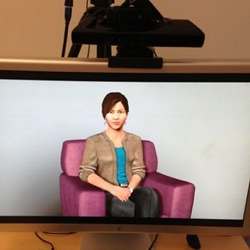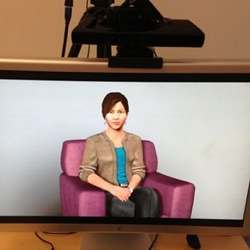
Researchers have discovered that people are sometimes more willing to share their fears when they are able to open up to a virtual interviewer, rather than to a real person.
Specifically, researchers at the University of Southern California (USC) Institute for Creative Technologies (ICT) found soldiers suffering from posttraumatic stress disorder (PTSD) were more likely to reveal their problem to a on-screen cartoon character (as opposed to a live human being) as long as they could be sure that information remained anonymous.
"Compared to the gold-standard post-deployment health assessment (PDHA) used by the U.S. military, our virtual interviewer was able to increase reporting of post-traumatic stress symptoms among soldiers by over three-fold," says Gale M. Lucas, a senior research associate at ICT and lead researcher on the study.
Moreover, while ICT's researchers are loathe to refer to their cartoon clinician (also known as 'Ellie') as a virtual therapist, others working in the same area see the ICT avatar as an inevitable precursor to virtual therapy.
"If a car can drive itself, a therapy session is probably not far behind," says Robert Schachter, a psychologist and press spokesperson for the Association of Cognitive and Behavioral Therapies (ACBT).
Ellie was able to build rapport with the 29 soldiers 'she' interviewed in the study by closely monitoring their smiles, frowns, gazes, and scores of other state-of-mind indicators as they engaged in conversation with her, according to ICT's Lucas. Simultaneously, Ellie also responded empathetically to those cues by nodding where appropriate, asking for more detail about a particular anecdote, commiserating with a soldier over a sad story, and offering other seemingly 'I-get-you' responses.
Under the hood, Ellie was able to pull off the human-like behavior with ICT's SimSensei software—artificial intelligence (AI) code that enables the avatar to recognize and respond to emotional cues for depression, anxiety, and PTSD.
In addition, the avatar tracked its interaction with soldiers in real time using face-tracking and head-tracking monitors, a COVAREP (Cooperative Voice Analysis Repository for Speech Technologies) speech analyzer, and an off-the-shelf desktop computer, monitor, webcam, and monitor, according to Stefan Scherer, a research assistant professor at ICT.
"I believe Ellie has a lot of potential," says Matthew Pickard, an assistant professor at the University of New Mexico (UNM) who is doing similar research into what are referred to as 'rapport agents.' "There is an element of anonymity and lack of social and moral judgment that a virtual human brings that reduces the risks individuals perceive in opening up to them."
Indeed, other research teams led by Jonathan Gratch and David DeVault at ICT have also demonstrated positive results from the technology.
Despite Ellie's accomplishments with soldiers, ICT is adamant its cartoon clinician is not a virtual therapist, nor is ICT interested in creating a virtual therapist.
"We are not in the business of creating a 'doc-in-a-box'," says Albert "Skip" Rizzo, ICT's director for medical virtual reality. "Rather, we aim to use rapport-building virtual human agents to engage patients with information that might help them to develop a better understanding of their situation and which may support them in making the decision to seek care with a live provider."
Even so, other researchers working in the space are willing to wax with more wonder as they weigh what Ellie has wrought.
UNM's Pickard, for example, sees an Age of Virtual Therapy as a challenge, but not at all impossible. "The semantics of communication alone are diverse and pervasive; the tilt of a head, the vocalic emphasis on a word, the synchronicity of a phrase and a non-verbal gesture," Pickard says.
"So, it takes a lot for a virtual human to 'pass the Turing test' and I think we are a long way from that milestone," Pickard says. "But virtual therapists can still be useful with far fewer capabilities than a human possesses; that is why I think AI-driven virtual therapists are inevitable."
Adds Schachter, "It looks as if AI (therapy) will be inevitable." Virtual therapy systems will become ever more personalized, becoming ever more attuned to the idiosyncrasies of the specific people they study, he says. Plus, all those insights and analyses will be carefully interwoven with curated clinical databases and artificial intelligence algorithms.
"The advantage of this is the potential of treating large numbers of people," Schachter says. "There will probably always be the individual who prefers human interaction, and for those, therapy will still require the human touch."
Overall, virtual therapy "could be a boon to our society," he says.
Joe Dysart is an Internet speaker and business consultant based in Manhattan, NY, USA.




Join the Discussion (0)
Become a Member or Sign In to Post a Comment